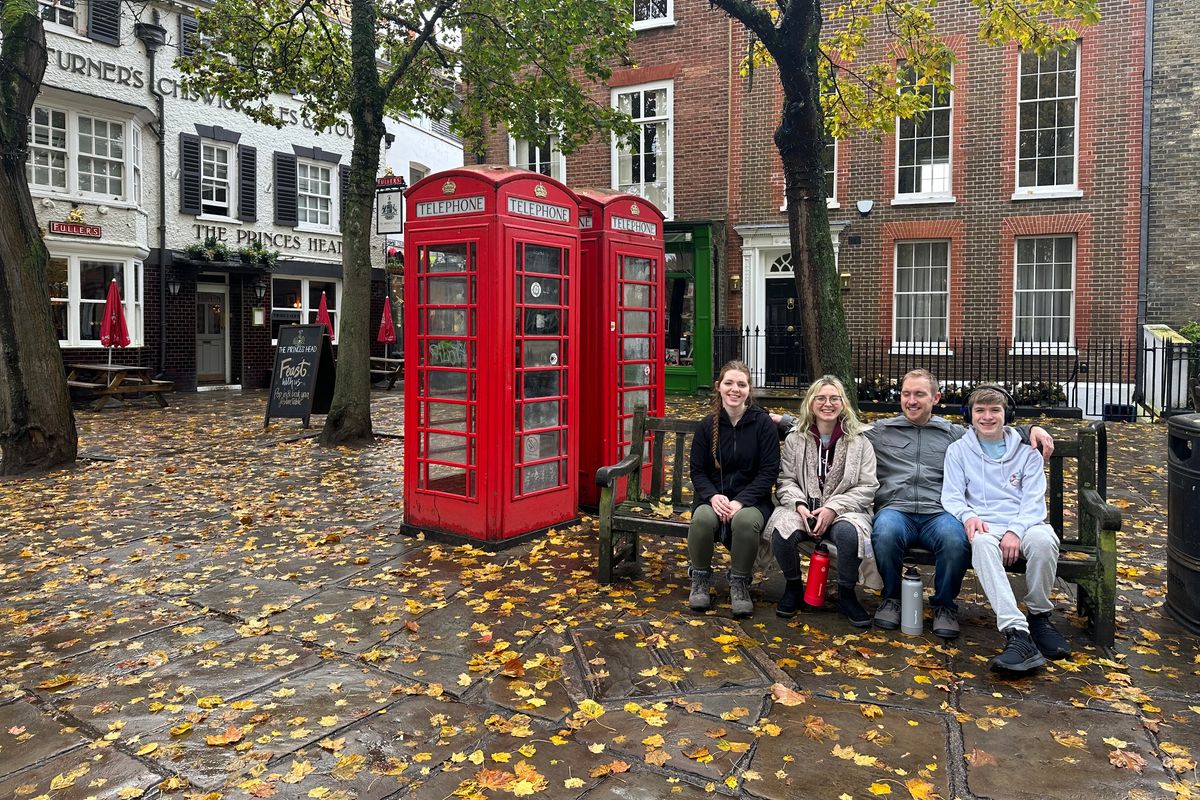My family just flew to three European countries and home again for $149 per person total
Here's how we traveled from the U.S. to London, Athens and Vienna and back again for less than the cost of one domestic flight.

My husband and kids sitting on Ted Lasso's bench in Richmond, U.K.
Our family of five just got back from a nearly 3-week European vacation—three different cities in three different countries—and we only paid $149 cash per person for all of our flights combined.
It sounds too good to be true, but it's not. It sounds like there's got to be a catch, and there is, but not like you might think.
Welcome to the world of travel hacking, where if you learn to play the points and miles game well, you can take vacations you (or at least I) never thought possible.
I started learning about the points and miles game in the fall of 2021 via the 10xTravel free course, and I started playing in earnest myself in February of 2022. As a result, in the past year and a half, our family has taken multiple flights and stayed at multiple hotels within the United States—including some schmancy resorts—for free or very close to free. (Certain taxes and fees on flights have to be paid in cash, so there's no such thing as a 100% free flight.) But this trip to Europe was our first foray into international travel with points.

My family enjoyed the Rathaus Christkindlmarket in Vienna.
Photo courtesy of Annie Reneau
The one "catch" to travel hacking? It's a complicated, strategic long game that takes time and effort to learn. But it's totally worth it. The basic gist is that you maximize credit card sign-up bonuses to accumulate transferable credit card points or loyalty points/miles with hotels and airlines, all without spending any more money than you normally would. Then you learn how to redeem those points for travel, which makes them way more valuable than simply getting cash back.
I wrote an overview of how the game works in a previous article (which you can read here), but I figured a real-life example is the best illustration.
For this trip to Europe, I transferred 362,500 Chase Ultimate Rewards credit card points to United Airlines. (My husband and I have accumulated over 1.2 million points and miles in the past year and a half, so this trip was barely a third of our points.) That's what all of our flights to, from and around Europe cost, plus one more flight paid for with Southwest points to get all the way home. The taxes and fees for all flights came out to $149 for each of us.

The Temple of Poseidon was a favorite of the whole family.
Photo courtesy of Annie Reneau
Our original itinerary was actually US > London > Athens > Tel Aviv > US, but obviously the Israel plans changed when the war began. We switched from Tel Aviv to Vienna for our music-loving kids just a couple of weeks before we departed. The flight from Vienna back to the US cost fewer points than the Tel Aviv to US flight, which made it so our added Athens to Vienna flight was covered by points we'd already spent. (We'd originally booked a one-way cash flight from Athens to Tel Aviv. That got refunded when the flight was canceled.) And thanks to United's Excursionist Perk, our London to Athens leg also cost us zero points—we only paid taxes.
So what you see here are the fees we paid out of pocket for three flights—Spokane to London, London to Athens, and Vienna to Chicago (where we stopped to see family and friends for a few days on our way home). The Oct 15 "date of purchase" was actually the date we changed our Tel Aviv flight to Vienna—we purchased the original tickets months ago.
As you can see, the fees for these flights were $112 per person:

Fees for flights from Spokane to London, London to Athens, and Vienna to Chicago
Screenshot via Annie Reneau
Here are the taxes and fees for the Athens to Vienna leg we added after the Israel changes, which were $31.40 per person:

Taxes and fees for flight from Athens to Vienna.
Screenshot via Annie Reneau
Finally, to get back to Spokane from Chicago, we booked flights on Southwest. We have a ton of Southwest Rapid Rewards points accumulated from playing the game as well as two Southwest Companion Passes, which means two of our kids traveled with us for free (only paid fees on their flights—no points needed). So we paid 14,345 Southwest points x 3 (43,035 points total) and the fees were just $5.60 each, which brings us to our grand total of $149 per person.

We paid $5.60 each for our flight from Chicago to Spokane on Southwest.
Screenshot via Annie Reneau
To reiterate, we didn't pay anything beyond our normal spending for the points we used to get these flights. We just strategically utilized new credit cards for all of our expenses every few months. Accumulating points is actually the simpler part of the game. Figuring how to find the best redemption deals for the points is where it gets complicated and the real work comes in.
It's not like I just went on the United website, put in our dates and destinations, transferred the points and got the tickets. I spent many hours poring over different airline websites and different city combinations and dates to see where the best deals were. (We weren't tied to particular cities or dates other than our religious pilgrimage to Haifa, which didn't end up happening anyway.) It took a lot of time to find these tickets for the price we did, but again, totally worth it to save thousands of dollars.

Our whole family at the tip of mainland Greece at sunset.
Photo courtesy of Annie Reneau
If there weren't as many of us, we could also have gotten hotels on points, but with a family of five it was more affordable to book Airbnbs where we were Europe. So it's not like this vacation cost us nothing—we still had accommodations, public transportation, a car rental in Greece for exploring outside of Athens for a few days, food (pretty cheap in Greece, more expensive in the U.K. and Austria), and any museums, attractions and events we enjoyed.
But getting the flights for a song enabled us to do the rest. The cash price for the exact same flight itinerary would have cost between $6,000 and $9,000 for the whole family, especially since most of our flights were direct and at desirable times. Even if we were to see the 362,500 Chase points we used for their straight cash back value ($3,625), we still got a good deal. But those points didn't cost us anything. And our family got to take the trip of a lifetime. Travel hacking for the win.
- My family of 5 traveled the U.S. for nearly a year, and it cost us less than staying home ›
- Man shares travel hack that made his business class flight 'cheaper than economy' ›
- The not-so-secret travel hacking 'game' that allows you to travel the world for free ›
- 9-year-old girl bullied for not having a Stanley bottle - Upworthy ›
- Brit in US explains why Americans don't seem 'well-traveled' - Upworthy ›
- Shocked parent discovers airline has moved toddler's seat - Upworthy ›
- Europeans playfully roast an American abroad for her 'primitive' fork and knife skills - Upworthy ›
- People recall their fleeting relationships from cruises and vacations and it's so wholesome - Upworthy ›
- European woman shares 11 unexpected realizations after living in America for 6 months - Upworthy ›




 Newborn's first cry marks a fresh beginning.
Newborn's first cry marks a fresh beginning. Newborn baby.
Newborn baby.



 Women walking down a street.Image via Canva Photos.
Women walking down a street.Image via Canva Photos.  Woman aware of her surroundings in a parking garage. Image via Canva Photos.
Woman aware of her surroundings in a parking garage. Image via Canva Photos.
 "You're hilariously brilliant at everything you hate."
"You're hilariously brilliant at everything you hate."  "Bridget is authentically herself…and triumphs in her own way."
"Bridget is authentically herself…and triumphs in her own way."  "They're written in some curious language that I can't really understand."
"They're written in some curious language that I can't really understand."